seats YAMAHA FX HO CRUISER 2018 Owners Manual
[x] Cancel search | Manufacturer: YAMAHA, Model Year: 2018, Model line: FX HO CRUISER, Model: YAMAHA FX HO CRUISER 2018Pages: 116, PDF Size: 4.84 MB
Page 5 of 116

Table of contents
General and important labels ........... 1
Identification numbers .................... 1
Primary Identification (PRI-ID)
number............................................ 1
Craft Identification Number (CIN) ....... 1
Engine serial number.......................... 1
Manufactured date label .................... 2
Model information ........................... 2
Builder’s plate .................................... 2
Important labels .............................. 4
Warning labels.................................... 5
Other labels ........................................ 8
Safety information ........................... 10
Limitations on who may operate
the watercraft ............................. 10
Cruising limitations ........................ 11
Operation requirements ................ 12
Recommended equipment ........... 14
Hazard information........................ 15
Watercraft characteristics ............. 15
Wakeboarding and water-skiing ... 17
Safe boating rules ......................... 18
Enjoy your watercraft
responsibly ................................. 19
Description....................................... 20
Watercraft glossary ....................... 20
Location of main components ...... 21
Control function operation ............. 25
Watercraft control functions ......... 25
Remote control transmitter .............. 25
Yamaha Security System ................. 26
Engine stop switch .......................... 27
Engine shut-off switch .................... 27
Start switch ..................................... 27
Throttle lever .................................... 28
RiDE lever ........................................ 28
Steering system ............................... 28
Adjustable tilt steering system ......... 29
Cooling water pilot outlet ................. 30
Water separator................................ 30
Watercraft operation ...................... 31
Watercraft operation functions ..... 31
Shift system ..................................... 31
Electric trim system .......................... 33
Watercraft operation modes ......... 35
Low RPM Mode ............................... 35
No-wake mode ................................. 36
Cruise assist ..................................... 37
Instrument operation ...................... 39
Multifunction information center ... 39
Analog speedometer/tachometer..... 39
Information display ........................... 40
Multifunction display ........................ 44
Equipment operation ...................... 48
Equipment..................................... 48
Seats ................................................ 48
Handgrip........................................... 49
Reboarding grip................................ 49
Reboarding step ............................... 49
Bow eye............................................ 50
Stern eyes ........................................ 50
Cleat ................................................. 50
Pull-up cleats (FX Cruiser HO).......... 51
Storage compartments .................... 51
Fire extinguisher holder and cover ... 56
Operation and handling
requirements ................................... 57
Fuel requirements ......................... 57
Fuel................................................... 57
Engine oil requirements ................ 60
Engine oil .......................................... 60
Draining the bilge water ................ 61
Draining the bilge water on land....... 61
Draining the bilge water on water .... 62
UF2T78E0.book Page 1 Wednesday, July 12, 2017 9:40 AM
Page 54 of 116
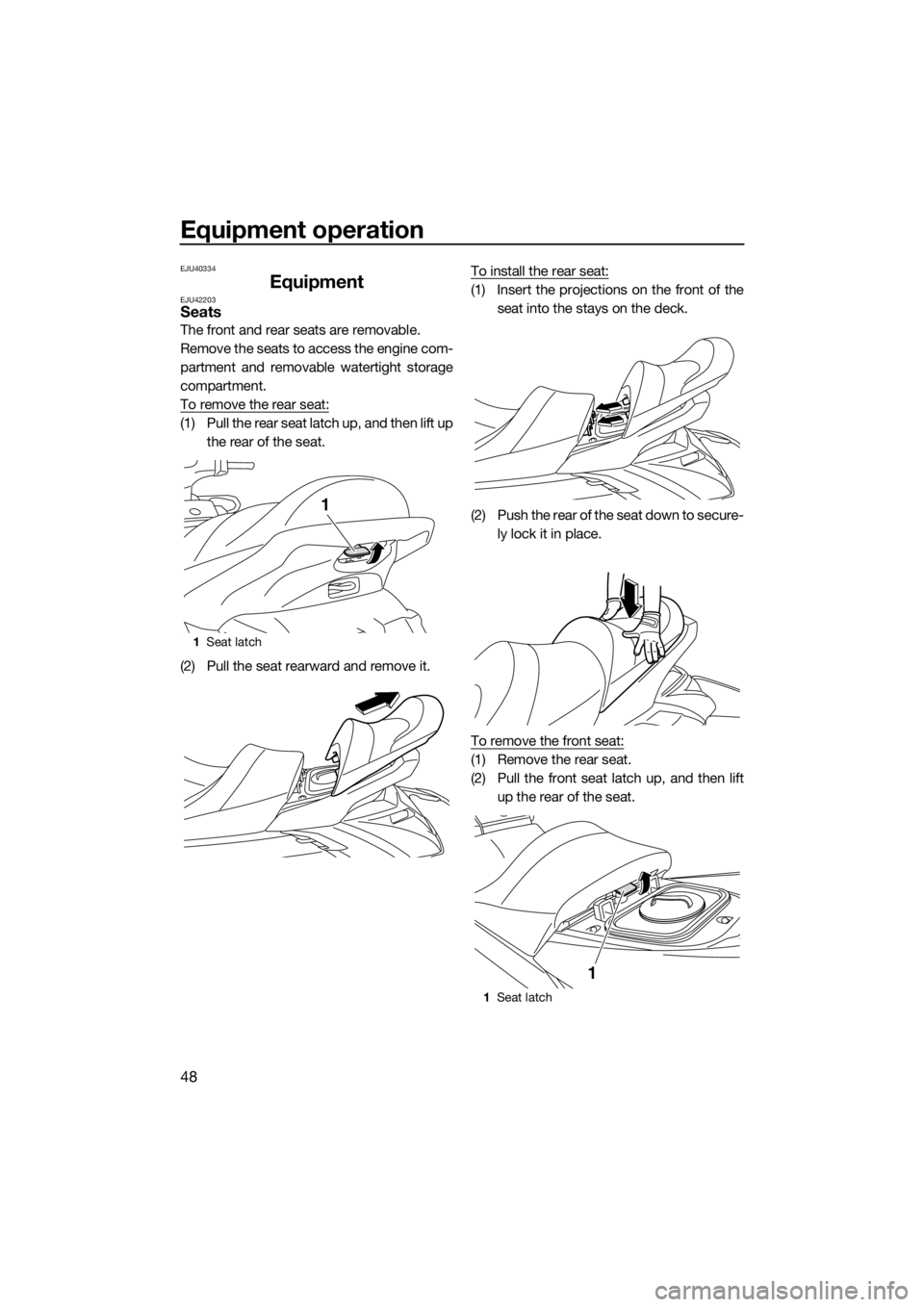
Equipment operation
48
EJU40334
EquipmentEJU42203Seats
The front and rear seats are removable.
Remove the seats to access the engine com-
partment and removable watertight storage
compartment.
To remove the rear seat:
(1) Pull the rear seat latch up, and then lift up
the rear of the seat.
(2) Pull the seat rearward and remove it.To install the rear seat:
(1) Insert the projections on the front of the
seat into the stays on the deck.
(2) Push the rear of the seat down to secure-
ly lock it in place.
To remove the front seat:
(1) Remove the rear seat.
(2) Pull the front seat latch up, and then lift
up the rear of the seat.
1Seat latch
1
1Seat latch
1
UF2T78E0.book Page 48 Wednesday, July 12, 2017 9:40 AM
Page 64 of 116
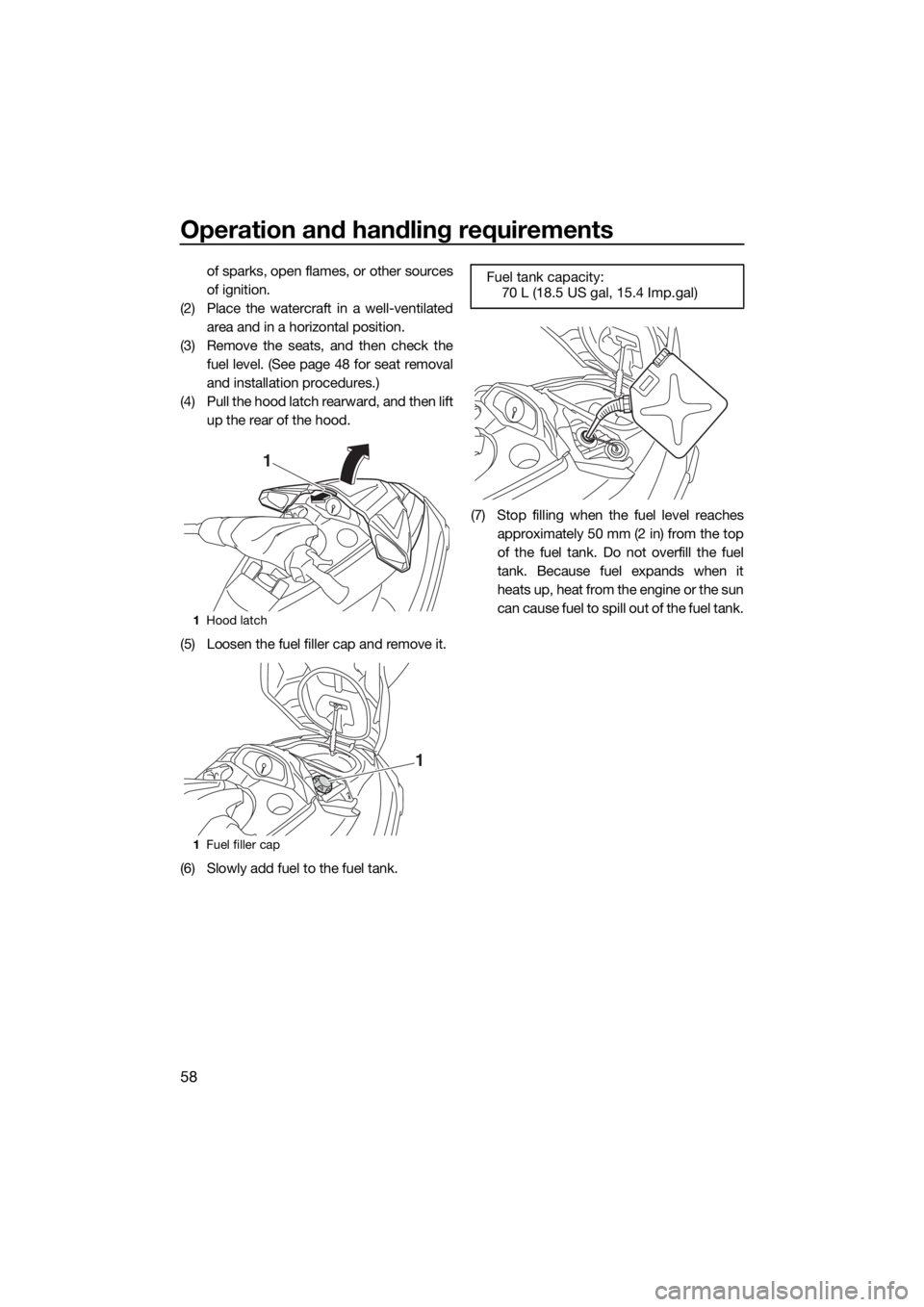
Operation and handling requirements
58
of sparks, open flames, or other sources
of ignition.
(2) Place the watercraft in a well-ventilated
area and in a horizontal position.
(3) Remove the seats, and then check the
fuel level. (See page 48 for seat removal
and installation procedures.)
(4) Pull the hood latch rearward, and then lift
up the rear of the hood.
(5) Loosen the fuel filler cap and remove it.
(6) Slowly add fuel to the fuel tank.(7) Stop filling when the fuel level reaches
approximately 50 mm (2 in) from the top
of the fuel tank. Do not overfill the fuel
tank. Because fuel expands when it
heats up, heat from the engine or the sun
can cause fuel to spill out of the fuel tank.
1Hood latch
1Fuel filler cap
1
1
Fuel tank capacity:
70 L (18.5 US gal, 15.4 Imp.gal)
UF2T78E0.book Page 58 Wednesday, July 12, 2017 9:40 AM
Page 65 of 116
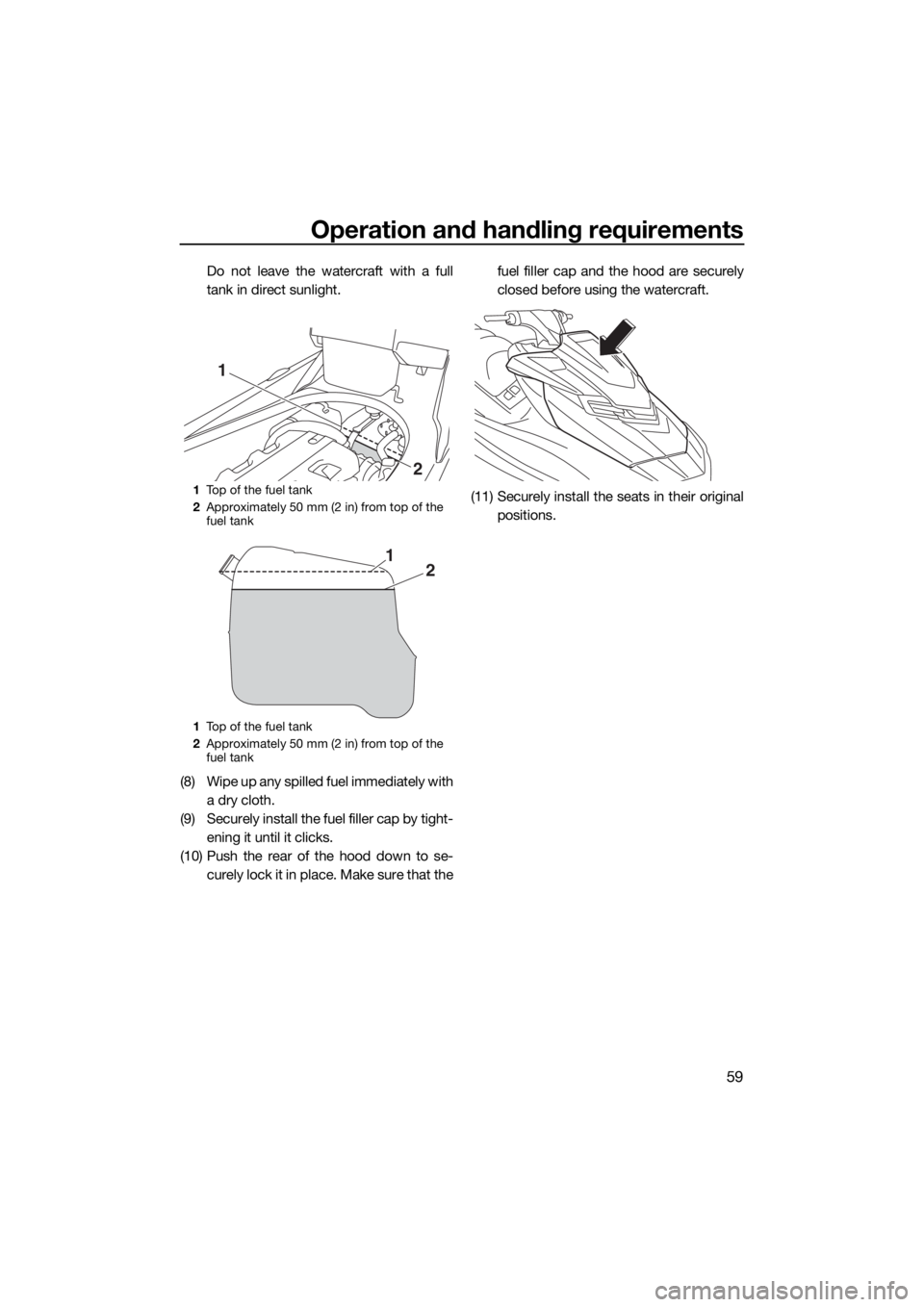
Operation and handling requirements
59
Do not leave the watercraft with a full
tank in direct sunlight.
(8) Wipe up any spilled fuel immediately with
a dry cloth.
(9) Securely install the fuel filler cap by tight-
ening it until it clicks.
(10) Push the rear of the hood down to se-
curely lock it in place. Make sure that thefuel filler cap and the hood are securely
closed before using the watercraft.
(11) Securely install the seats in their original
positions.
1Top of the fuel tank
2Approximately 50 mm (2 in) from top of the
fuel tank
1Top of the fuel tank
2Approximately 50 mm (2 in) from top of the
fuel tank
1
2
21
UF2T78E0.book Page 59 Wednesday, July 12, 2017 9:40 AM
Page 66 of 116
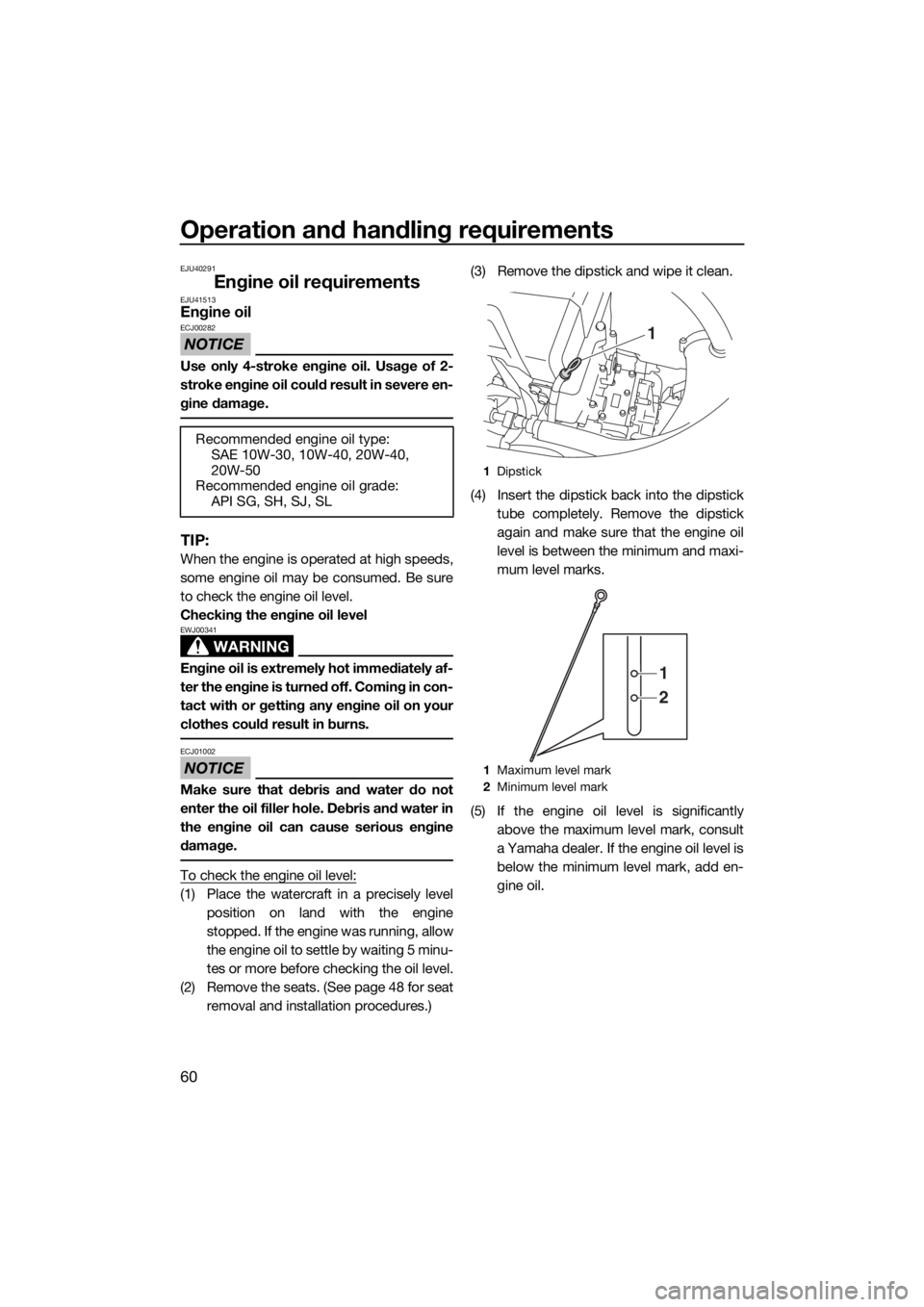
Operation and handling requirements
60
EJU40291
Engine oil requirementsEJU41513Engine oil
NOTICE
ECJ00282
Use only 4-stroke engine oil. Usage of 2-
stroke engine oil could result in severe en-
gine damage.
TIP:
When the engine is operated at high speeds,
some engine oil may be consumed. Be sure
to check the engine oil level.
Checking the engine oil level
WARNING
EWJ00341
Engine oil is extremely hot immediately af-
ter the engine is turned off. Coming in con-
tact with or getting any engine oil on your
clothes could result in burns.
NOTICE
ECJ01002
Make sure that debris and water do not
enter the oil filler hole. Debris and water in
the engine oil can cause serious engine
damage.
To check the engine oil level:
(1) Place the watercraft in a precisely level
position on land with the engine
stopped. If the engine was running, allow
the engine oil to settle by waiting 5 minu-
tes or more before checking the oil level.
(2) Remove the seats. (See page 48 for seat
removal and installation procedures.)(3) Remove the dipstick and wipe it clean.
(4) Insert the dipstick back into the dipstick
tube completely. Remove the dipstick
again and make sure that the engine oil
level is between the minimum and maxi-
mum level marks.
(5) If the engine oil level is significantly
above the maximum level mark, consult
a Yamaha dealer. If the engine oil level is
below the minimum level mark, add en-
gine oil. Recommended engine oil type:
SAE 10W-30, 10W-40, 20W-40,
20W-50
Recommended engine oil grade:
API SG, SH, SJ, SL
1Dipstick
1Maximum level mark
2Minimum level mark
1
1
2
UF2T78E0.book Page 60 Wednesday, July 12, 2017 9:40 AM
Page 67 of 116
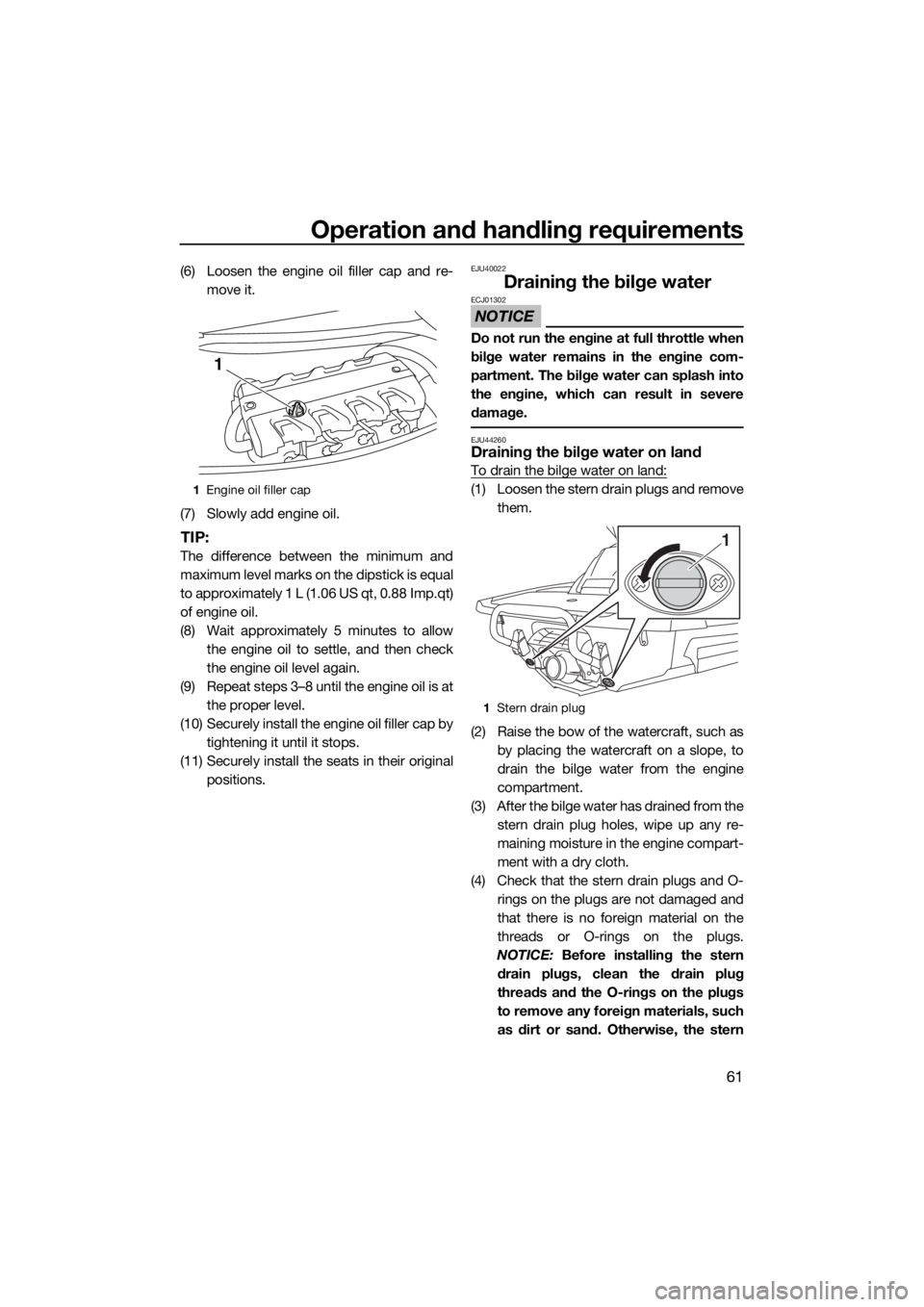
Operation and handling requirements
61
(6) Loosen the engine oil filler cap and re-
move it.
(7) Slowly add engine oil.
TIP:
The difference between the minimum and
maximum level marks on the dipstick is equal
to approximately 1 L (1.06 US qt, 0.88 Imp.qt)
of engine oil.
(8) Wait approximately 5 minutes to allow
the engine oil to settle, and then check
the engine oil level again.
(9) Repeat steps 3–8 until the engine oil is at
the proper level.
(10) Securely install the engine oil filler cap by
tightening it until it stops.
(11) Securely install the seats in their original
positions.
EJU40022
Draining the bilge water
NOTICE
ECJ01302
Do not run the engine at full throttle when
bilge water remains in the engine com-
partment. The bilge water can splash into
the engine, which can result in severe
damage.
EJU44260Draining the bilge water on land
To drain the bilge water on land:
(1) Loosen the stern drain plugs and remove
them.
(2) Raise the bow of the watercraft, such as
by placing the watercraft on a slope, to
drain the bilge water from the engine
compartment.
(3) After the bilge water has drained from the
stern drain plug holes, wipe up any re-
maining moisture in the engine compart-
ment with a dry cloth.
(4) Check that the stern drain plugs and O-
rings on the plugs are not damaged and
that there is no foreign material on the
threads or O-rings on the plugs.
NOTICE: Before installing the stern
drain plugs, clean the drain plug
threads and the O-rings on the plugs
to remove any foreign materials, such
as dirt or sand. Otherwise, the stern1Engine oil filler cap
1
1Stern drain plug
1
UF2T78E0.book Page 61 Wednesday, July 12, 2017 9:40 AM
Page 72 of 116

Pre-operation checks
66
TIP:
To ensure safety and reliability, pre-operation checks should be made each time the water-
craft is used.
Jet thrust nozzle and re-
verse gate Check the jet thrust nozzle and reverse gate for
damage.72
Stern drain plugsCheck the stern drain plugs for damage and foreign
material and check that they are securely installed.72
HoodCheck that the hood is securely closed. 73
Front and rear seatsCheck that the seats are securely installed. 48
POST-LAUNCH CHECKS
Cooling water pilot outletCheck that water is discharged from the cooling
water pilot outlet while the engine is running.73
Multifunction information
centerCheck the multifunction information center for prop-
er operation.73
Shift system Check the shift system for proper operation. 74
Trim indicatorCheck the trim indicator for proper operation. 74
Engine idling speedCheck the engine idling speed. 74 ITEM ROUTINE PAGE
UF2T78E0.book Page 66 Wednesday, July 12, 2017 9:40 AM
Page 73 of 116
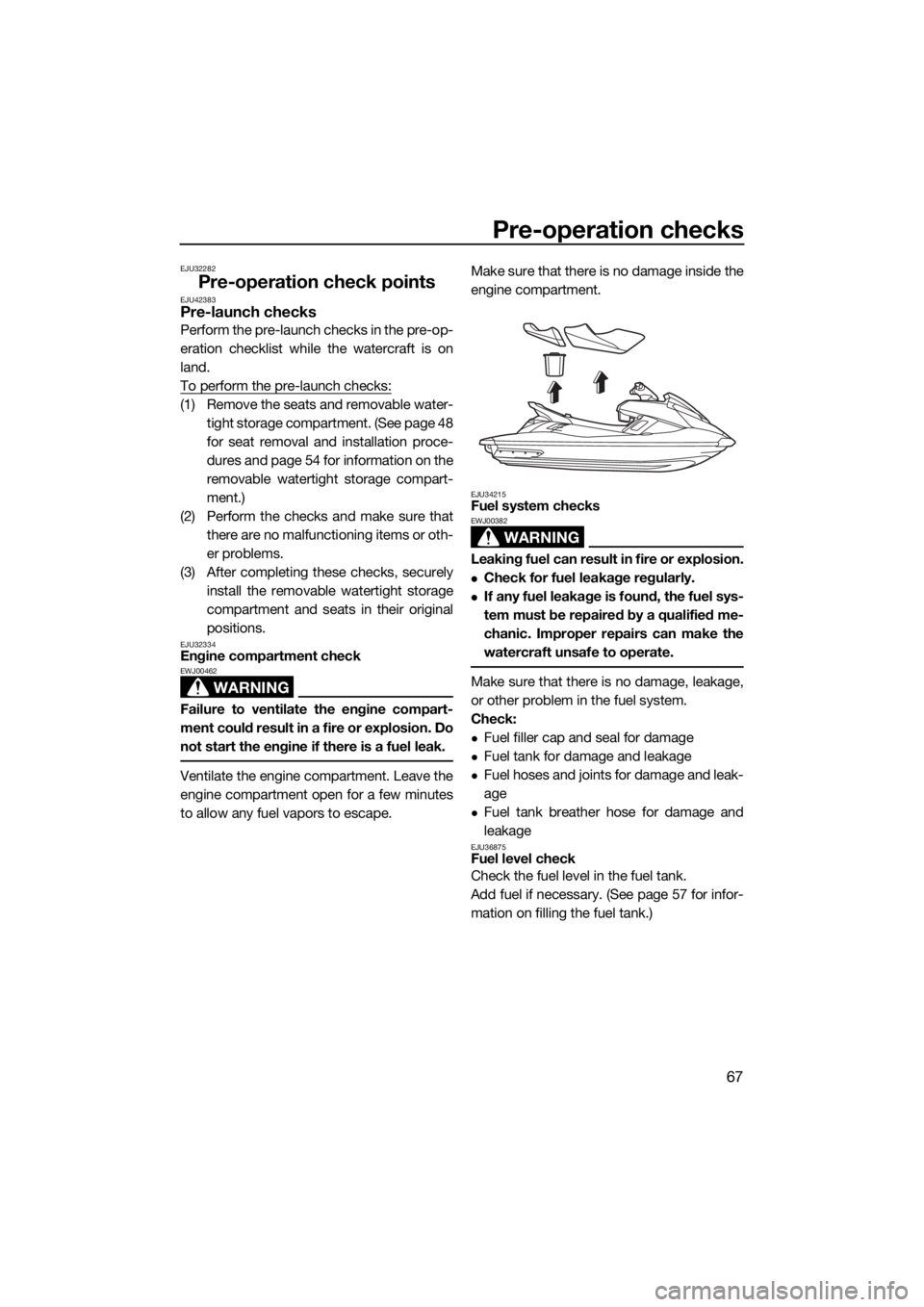
Pre-operation checks
67
EJU32282
Pre-operation check pointsEJU42383Pre-launch checks
Perform the pre-launch checks in the pre-op-
eration checklist while the watercraft is on
land.
To perform the pre-launch checks:
(1) Remove the seats and removable water-
tight storage compartment. (See page 48
for seat removal and installation proce-
dures and page 54 for information on the
removable watertight storage compart-
ment.)
(2) Perform the checks and make sure that
there are no malfunctioning items or oth-
er problems.
(3) After completing these checks, securely
install the removable watertight storage
compartment and seats in their original
positions.
EJU32334Engine compartment check
WARNING
EWJ00462
Failure to ventilate the engine compart-
ment could result in a fire or explosion. Do
not start the engine if there is a fuel leak.
Ventilate the engine compartment. Leave the
engine compartment open for a few minutes
to allow any fuel vapors to escape.Make sure that there is no damage inside the
engine compartment.
EJU34215Fuel system checks
WARNING
EWJ00382
Leaking fuel can result in fire or explosion.
Check for fuel leakage regularly.
If any fuel leakage is found, the fuel sys-
tem must be repaired by a qualified me-
chanic. Improper repairs can make the
watercraft unsafe to operate.
Make sure that there is no damage, leakage,
or other problem in the fuel system.
Check:
Fuel filler cap and seal for damage
Fuel tank for damage and leakage
Fuel hoses and joints for damage and leak-
age
Fuel tank breather hose for damage and
leakage
EJU36875Fuel level check
Check the fuel level in the fuel tank.
Add fuel if necessary. (See page 57 for infor-
mation on filling the fuel tank.)
UF2T78E0.book Page 67 Wednesday, July 12, 2017 9:40 AM
Page 93 of 116
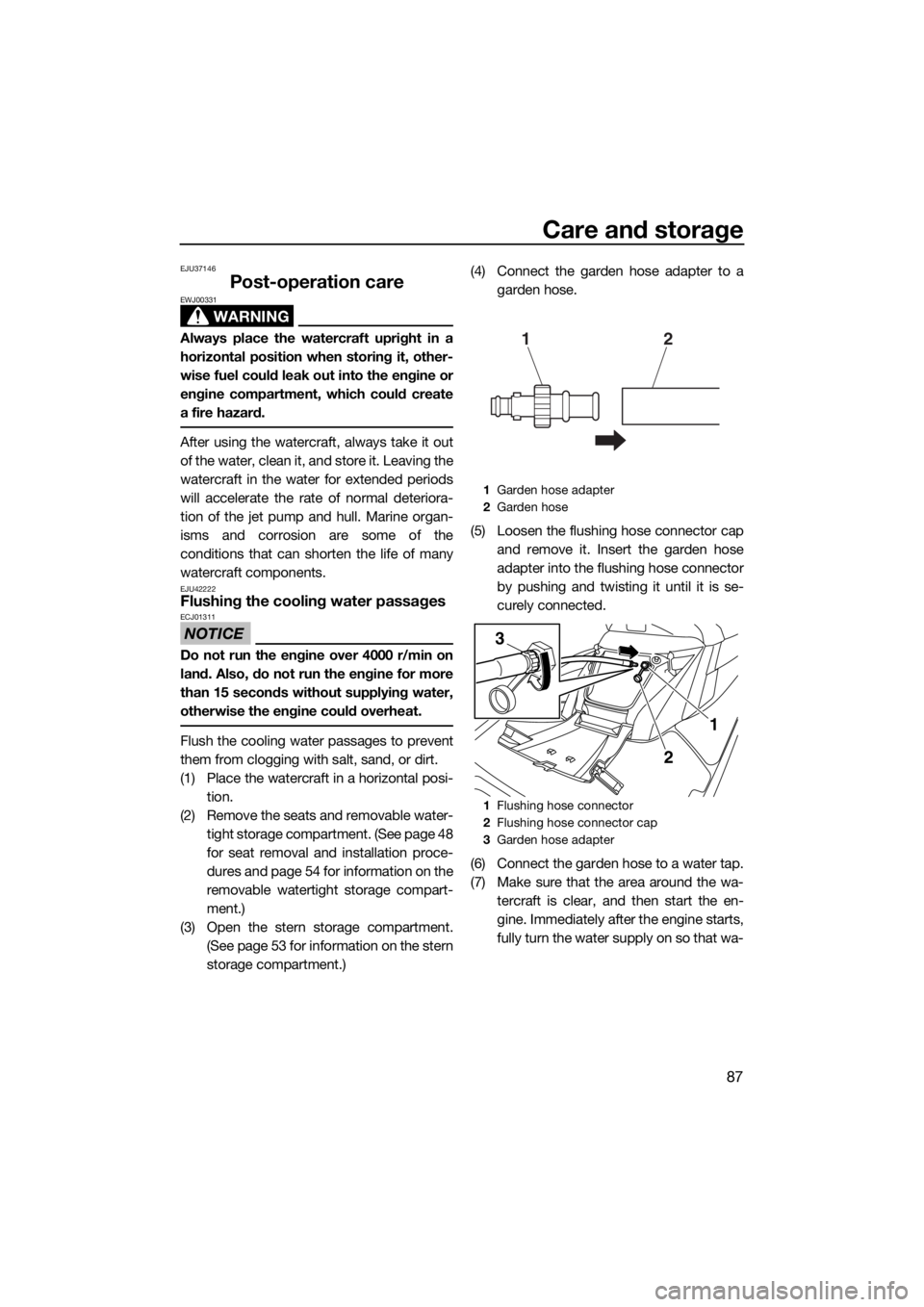
Care and storage
87
EJU37146
Post-operation care
WARNING
EWJ00331
Always place the watercraft upright in a
horizontal position when storing it, other-
wise fuel could leak out into the engine or
engine compartment, which could create
a fire hazard.
After using the watercraft, always take it out
of the water, clean it, and store it. Leaving the
watercraft in the water for extended periods
will accelerate the rate of normal deteriora-
tion of the jet pump and hull. Marine organ-
isms and corrosion are some of the
conditions that can shorten the life of many
watercraft components.
EJU42222Flushing the cooling water passages
NOTICE
ECJ01311
Do not run the engine over 4000 r/min on
land. Also, do not run the engine for more
than 15 seconds without supplying water,
otherwise the engine could overheat.
Flush the cooling water passages to prevent
them from clogging with salt, sand, or dirt.
(1) Place the watercraft in a horizontal posi-
tion.
(2) Remove the seats and removable water-
tight storage compartment. (See page 48
for seat removal and installation proce-
dures and page 54 for information on the
removable watertight storage compart-
ment.)
(3) Open the stern storage compartment.
(See page 53 for information on the stern
storage compartment.)(4) Connect the garden hose adapter to a
garden hose.
(5) Loosen the flushing hose connector cap
and remove it. Insert the garden hose
adapter into the flushing hose connector
by pushing and twisting it until it is se-
curely connected.
(6) Connect the garden hose to a water tap.
(7) Make sure that the area around the wa-
tercraft is clear, and then start the en-
gine. Immediately after the engine starts,
fully turn the water supply on so that wa-
1Garden hose adapter
2Garden hose
1Flushing hose connector
2Flushing hose connector cap
3Garden hose adapter
12
1
3
2
UF2T78E0.book Page 87 Wednesday, July 12, 2017 9:40 AM
Page 94 of 116
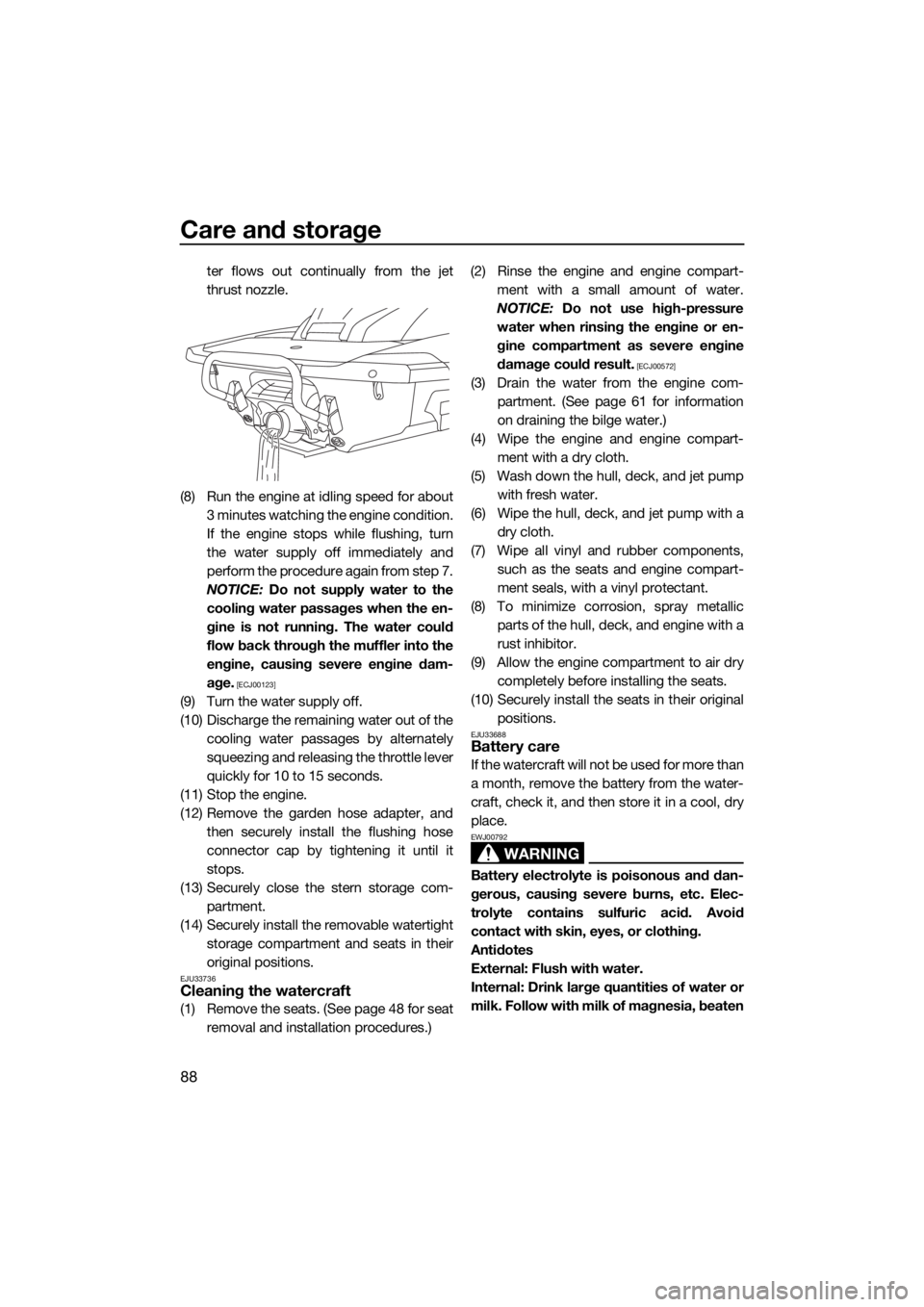
Care and storage
88
ter flows out continually from the jet
thrust nozzle.
(8) Run the engine at idling speed for about
3 minutes watching the engine condition.
If the engine stops while flushing, turn
the water supply off immediately and
perform the procedure again from step 7.
NOTICE: Do not supply water to the
cooling water passages when the en-
gine is not running. The water could
flow back through the muffler into the
engine, causing severe engine dam-
age.
[ECJ00123]
(9) Turn the water supply off.
(10) Discharge the remaining water out of the
cooling water passages by alternately
squeezing and releasing the throttle lever
quickly for 10 to 15 seconds.
(11) Stop the engine.
(12) Remove the garden hose adapter, and
then securely install the flushing hose
connector cap by tightening it until it
stops.
(13) Securely close the stern storage com-
partment.
(14) Securely install the removable watertight
storage compartment and seats in their
original positions.
EJU33736Cleaning the watercraft
(1) Remove the seats. (See page 48 for seat
removal and installation procedures.)(2) Rinse the engine and engine compart-
ment with a small amount of water.
NOTICE: Do not use high-pressure
water when rinsing the engine or en-
gine compartment as severe engine
damage could result.
[ECJ00572]
(3) Drain the water from the engine com-
partment. (See page 61 for information
on draining the bilge water.)
(4) Wipe the engine and engine compart-
ment with a dry cloth.
(5) Wash down the hull, deck, and jet pump
with fresh water.
(6) Wipe the hull, deck, and jet pump with a
dry cloth.
(7) Wipe all vinyl and rubber components,
such as the seats and engine compart-
ment seals, with a vinyl protectant.
(8) To minimize corrosion, spray metallic
parts of the hull, deck, and engine with a
rust inhibitor.
(9) Allow the engine compartment to air dry
completely before installing the seats.
(10) Securely install the seats in their original
positions.
EJU33688Battery care
If the watercraft will not be used for more than
a month, remove the battery from the water-
craft, check it, and then store it in a cool, dry
place.
WARNING
EWJ00792
Battery electrolyte is poisonous and dan-
gerous, causing severe burns, etc. Elec-
trolyte contains sulfuric acid. Avoid
contact with skin, eyes, or clothing.
Antidotes
External: Flush with water.
Internal: Drink large quantities of water or
milk. Follow with milk of magnesia, beaten
UF2T78E0.book Page 88 Wednesday, July 12, 2017 9:40 AM